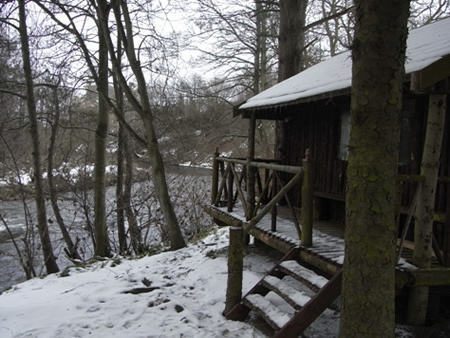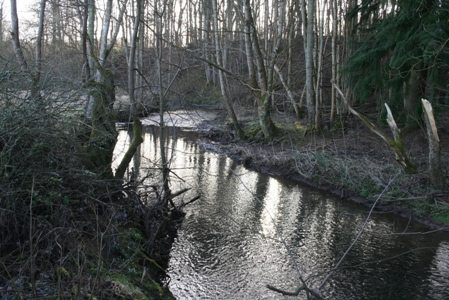These bulletin blogs represent news about Finavon and the South Esk, and my views as a riparian owner. They are not the views of any other organisation, nor are they designed to promote the interests of any individual or organisation other than Finavon Castle Water and factors affecting the fishery. Tony Andrews
John Wood fished down the whole Water yesterday – all four beats – and, apart from a strong, well-mended kelt in Haughs, there was no sign of fresh salmon in FCW pools. John told me that the water temperature was 36F which explains why Upper Kinnaird has had a few more fish than usual in the last two weeks. Even with Kinnaird Dyke much improved in terms of passage for salmon and sea trout the truth is that in these very cold conditions at this time of year salmon will be held up by obstructions that in higher temperatures would be fairly innocuous.
The end of March in 2013 has been the coldest spring for many years. The photo above shows icicles on the Red Brae hut and fresh snow on the ground on 25/3/2013. The water temperature was 36F.
It is encouraging that Marine Scotland scientists have already trapped and tahgged three salmon at Kinnaird, well within the South Esk, although, as I have mentioned before, that is no guarantee that they will stay in the river. In cold water it has been shown during previous radio tagging projects that salmon will regurgitate a high number of radio tags (c.30%). After the salmon has spewed them up these tags continue to transmit from the bed of the river, perhaps jammed behind a rock.
In April 2012 a team of volunteers cleaned up the Lemno Burn between Milton of Finavon village and the confluence weith the South Esk at Red Brae. The unblocking of years or rubbish and fallen branches released a lot of trapped silt. When followed by a long summer, autumn and winter of unusually high water levels, the effect has been to wash through the lower reaches of this spawning and nursery tributary. We can now see gravels and rifflres have appeared where previously there were none. With the removal of much of the mid-range canopy more light now reaches the burn with the result that both aquatic and riparian annuals and perennials are starting to grow. We will need to keep on top of the maintenance of this important South Esk tributary.
More snow has fallen on top of icy drifts in the glens, making the hills prone to avalanches and as dangerous as they can be. For the river, this huge reservoir of snowmelt yet to come should provide the water that our spring salmon so badly need to enter the South Esk. The question is “will it be a year of abundance, as 2011 was, or will it be a poor year in terms of spring salmon numbers, as 2012 was?” We can but wait…
TA on 26/3/2013

